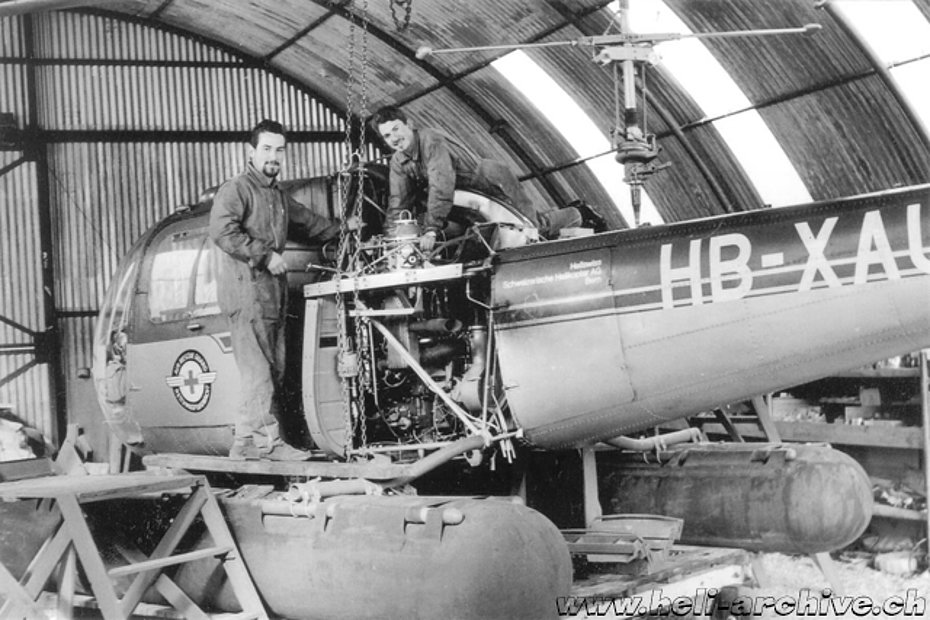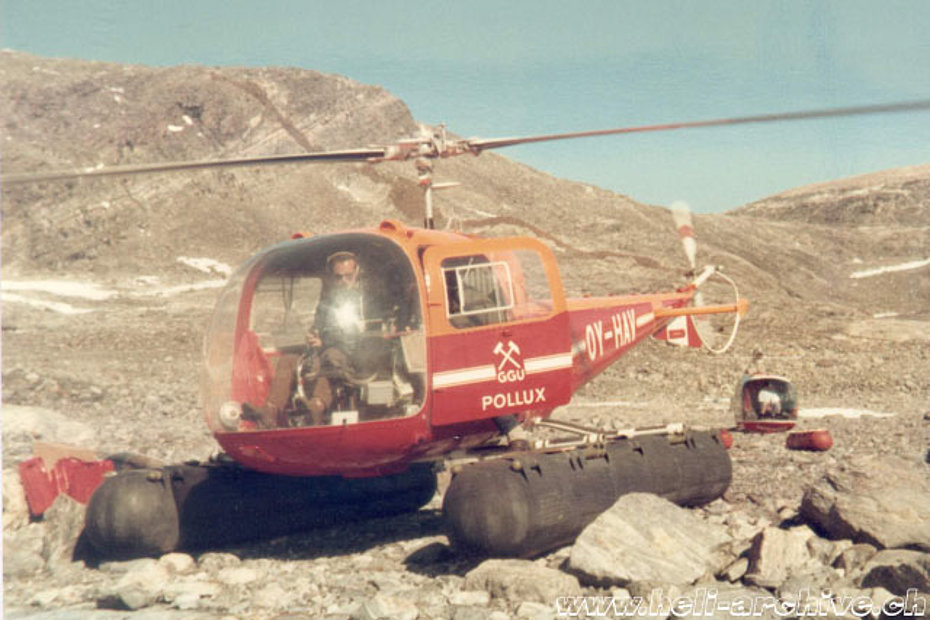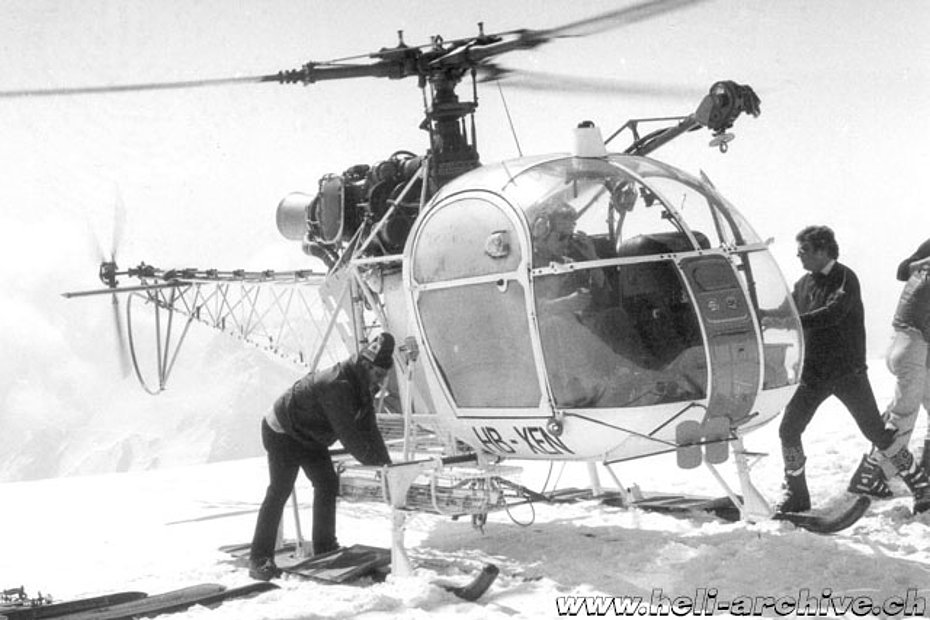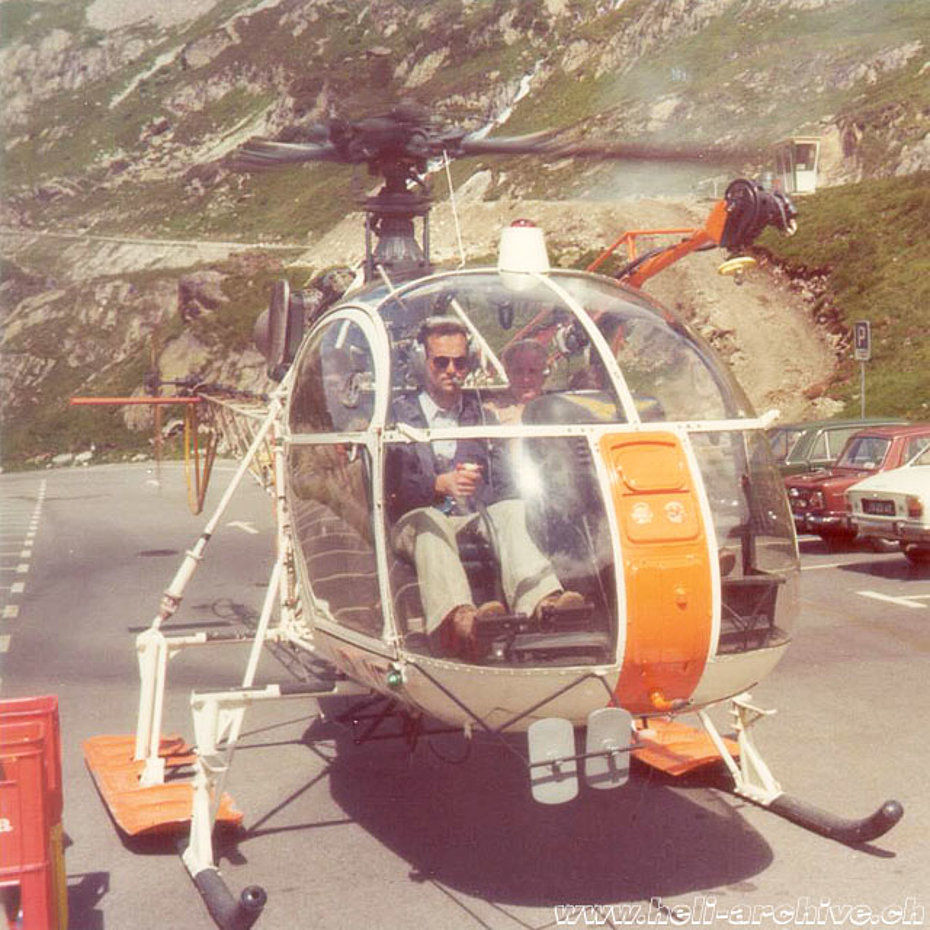
Schmid Paul
In my archive I have an old black and white image dating back to 1967 with four young men photographed on the deck of a ship bound for Greenland. All became helicopter pilots but unfortunately two died in a helicopter crash. One of them was Paul Schmid, and this is his story.
Paul Schmid was born in Frutigen/BE on October 27, 1945 and grew up in Kandergrund, a village located in the Bernese Oberland, surrounded by green hills, meadows and mountains. Here along with three sisters and a brother he spent his childhood and attended the compulsory schools. He then went to Lausanne for one year to improve his French language knowledge.
On May 2, 1962 he undertook a four years apprenticeship as a mechanic with the BLS railway company in Spiez/ BE.
However the young Paul was more interested in aviation world also in trains. Therefore during his spare time he began to hang out at the small airfield of Reichenbach located not far from Kandergrund and becoming a member of the local flying club.

On July 20, 1964 he received a student license and a few days later he took his first flight lesson at the controls of the Piper J-3 Cub HB-OHO with instructor Robi Imhof.
At the end of his apprenticeship Paul was forced to suspend his aviation training as he was drafted to the national compulsory military service during which time he was incorporated as an aviation mechanic in the military airfield in Payerne where he became a specialist in the maintenance of the De Havilland DH-112 Venom’s jet engines.
At the end of the military service Paul resumed his flight training, this time with no further interruptions.
On June 20, 1965 always at the airport of Reichenbach he undertook his solo flight on board the Piper J-3 Cub HB-OHO.
On June 3, 1966 after having completed just over 30 hours of flight training, the Federal Office of Civil Aviation (FOCA) issued him with the private pilot license.
In the following years he continued to fly as a private pilot on various aircraft types, including the Cessna 150, Cessna 172, Morane-Saulnier Rallye MS.880B and SIAI-Marchetti S.205.

Helicopter Mechanic
By November 1, 1966 Paul Schmid was hired by Heliswiss as a helicopter mechanic.
In May of the following year he was sent along with some work colleagues to Greenland to take over the maintenance of the two Bell 47J Ranger used by a group of geologists.
Paul returned several times to Greenland, at first as a mechanic then as a helicopter pilot.

Helicopter pilot
After a few years Paul’s interest for the rotary-wing was such that he decided to obtain the commercial helicopter pilot licence.
On February 23, 1969 along with flight instructor Georg Wedtgrube he began helicopter training at the airport of Samedan/GR at the controls of Agusta-Bell 47G3B-1 HB-XCI.
On March 15, 1969, after only 9h5’ of instruction he completed his first solo flight. The flight training continued during the following months under instructor Ueli Bärfuss.
On June 2, 1969 with a total flight experience of about 25 hours and 411 landings under his belt, he successfully passed his practical examination in Belp/BE and obtained the helicopter private pilot licence nr. 164.
All the training was made at the controls of the Agusta-Bell 47G3B-1 HB-XCI and HB-XBZ.
A few days later the new pilot left Switzerland and went to Greenland where he worked again as a helicopter mechanic. However during the summer he had the opportunity to fly as a co-pilot together with instructor Jean Seydoux.
In autumn, after his return to Switzerland, he had the opportunity to fly (always as co-pilot) together with pilots Jean-Bernard Schmid and Walter Tschumi who were flying the two Agusta-Bell 204B in service with Heliswiss.
From October 8, along with Jean Seydoux, he started the practical course in Belp/BE with the aim to obtain his commercial helicopter pilot licence. FOCA issued him this licence (nr. 164) on December 29, 1969.
From February 13, 1970 on, along with flight instructor Ueli Bärfuss, Paul Schmid began the specific course in Samedan/GR at the controls of the Bell 47G3B-1 HB-XBT which enabled him to land in the mountains. This special course ended April 21.
Almost during the same period the young helicopter pilot began to work as a commercial helicopter pilot under the supervision of an instructor.
During the month of April 1970, in view of his imminent deployment to Greenland, he was trained to fly with the Bell 47J Ranger by Jean Seydoux. The training included transportation of bulky loads suspended to the barycentric hook.
From June 4, 1970 Paul Schmid, who had a total flight experience of about 180 hours under his belt (of which just over 21 as a pilot in command), became engaged in the transportation of men and equipment on behalf of the GGU geological expedition at the controls of Agusta-Bell 47J Ranger OY-HAV.

He returned to Switzerland on September 6, 1970, at the end of his assignment in Greenland. His logbook indicates that over the summer he logged more than 200 hours.
A couple of months later, on November 3, Paul began the transition course on Bell 206A Jet Ranger under instructor Walter Demuth.
During the following months his flying activity was considerably reduced due to lack of work.
The following year, on June 6, 1971, Paul was again transferred to Greenland. Unfortunately, a few days later on June 16, Austrian pilot Peter Gschwend who was flying the Bell 47J Ranger HB-XAU along the same route (the two helicopters took-off from the same point within a short interval) disappeared in the sea.
Paul made numerous patrol flights but without success. Despite the extensive search action neither the helicopter nor the pilot body were ever found. Therefore the cause of the accident could never be ascertained and the tragedy remains wrapped in mystery.
At the beginning of September the Swiss pilot returned to Switzerland where he completed his training course on the Bell 206A Jet Ranger.

Just two months later, at the beginning of November 1971, he returned to Greenland where he remained until March of the following year. After a short period at home at the end of May 1972 he was again transferred to Greenland where he remained until September along with Ernest Devaud, another young Swiss helicopter pilot who had just started his career as a professional pilot.
On August 22, 1972 Paul Schmid, along with his work colleague Ernest Devaud, rescued two geologists who were isolated in a remote area after a storm. For this risky rescue mission the two Swiss pilots received a distinction form the Danish government.

At that time a considerable part of Heliswiss’ flying activity took place abroad and therefore Paul Schmid did not stay at home much.
On October 24, 1972 he began to fly one of the two Bell 206A Jet Ranger of Heliswiss based in Suriname. He remained in South America until the middle of December.
As usual during winter, flight activity was considerably reduced.

Transition on the SA 315B Lama
In Spring 1973 Heliswiss purchased its first SA 315B Lama (HB-XDZ) and therefore between April 17 and 19 Paul Schmid attended a pilot course in Marignane/France where he was trained to fly with the new helicopter.
HB-XDZ was transferred to Switzerland as a ferry flight and subsequently based at the heliport of Erstfeld/UR where it was used for the transportation of passengers, goods and building materials and SAR operations especially within the Canton of Uri, the Bernese Oberland, and in the Cantons of Schwyz, Unterwalden, Glarus and Nidwalden. Whenever necessary Paul was sent with his helicopter to work in the region of Surselva or also in the South of the Alps.
During the winter Paul was occasionally in Samedan or Laax (Canton Graubünden) where the helicopter was employed for supply flights, heli skiing or search and rescue operations as it happened during the world ski championships organized in San Moritz/GR in February 1974 where along with Ueli Bärfuss he transported a numerous people and equipment in the Piz Nair region.
The incident
On Sunday June 15, 1975 the Swiss Air Rescue Guard (SARG) received a distress call. A skier had been reported missing in the alpine region of the Susten. The skier had left his companions some hours earlier and these latter, not seeing him arriving at the agreed meeting point, alarmed the SARG, ignoring the possibility that the man could have walked home.
The skier informed his companion only late in the afternoon that he had safely walked home. Unfortunately it was then no longer possible to warn the pilot by radio.
Paul Schmid accompanied by alpine guides Bruno Kohler and Emil Johannes Streich carried out a reconnaissance flight in the Susten region where the weather conditions were characterized by the presence of clouds, thunderstorms and turbulences.
The helicopter was initially observed patrolling the mountain walls of the Gwächtenhorn but what happened then is wrapped in mystery.
The incident occurred at about 17:45 but the wreckage of the helicopter with the bodies of the three occupants was only located the following day 400 meters SW of the summit of the Chelenlücke (also known as Tierberglimi) at an altitude of 3'180 meters.
The report of the Swiss Aircraft Accident Investigation Bureau indicates two possible accident causes: a sudden collision with terrain due to loss of visual references (white-out), or loss of control following a collision of the rotor with a large bird.
Once again the negligence of a man led to a fatal accident, causing the loss of three human lives.
Paul Schmid, who was not yet 30 years old, left behind his wife Hanni whom he had married on April 10 and never knew his son Christian who was born on December 19.
Markus Burkhard, at that time employed by BOHAG as a helicopter pilot and who was a great friend of Paul with whom he had spent much time together especially during their deployment to Greenland, was charged of transporting the bodies of the three unlucky occupants to the base.

At the time of the fatal accident Paul Schmid, who is still fondly remembered by his friends and work colleagues, had accumulated 2'285 hours of flight under his belt, of which 795 at the controls of the SA 315B Lama.
In addition to the helicopters mentioned he also piloted the SE 3160 Alouette 3 and the Hughes 300 even if with these models he performed only a few flights.
HAB 06/2015

